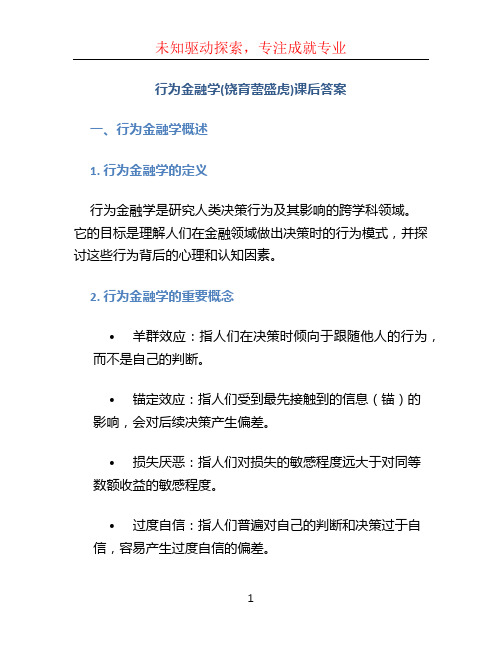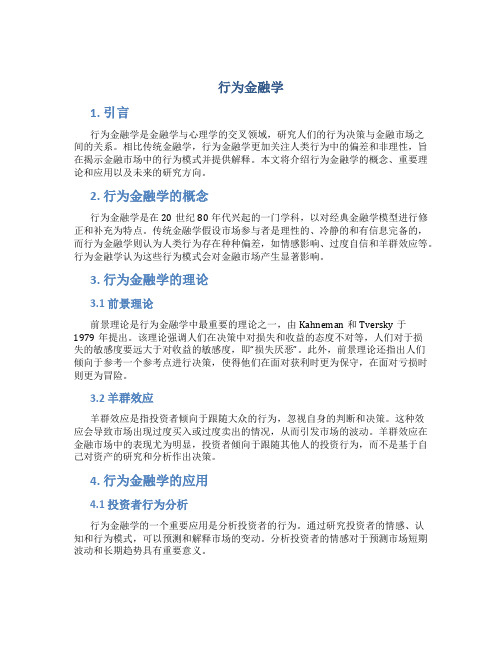行为金融学
行为金融学

第一部分行为金融学(Behavior Finance)的产生一、什么是行为金融学?行为金融学是以心理学以及其他相关学科的成果作为基础,与金融学相结合,探讨和解决金融问题的科学。
二、传统金融学两大基石:EMH和CAPM(一)有效市场假说Fama 的EMH (efficient markets hypothesis, EMH)被赋予三种不同的信息效率,即弱式有效、半强有效和强式有效。
1、弱式有效假设弱式有效假设(Weak-Form Efficiency Hypothesis):证券价格完全反映了市场交易方面的历史信息。
意味着投资者不能用过去的交易资料预测未来收益,不能从证券价格走势中找到规律并用来获取长期超额收益。
即技术分析无效2、半强式有效假设半强式有效假设(Semistrong-Form Efficiency Hypothesis) , 证券价格完全反映了所有公开的市场信息和基本信息。
意味着投资者既不能利用过去价格的历史信息,也不能运用公开的基本面信息来分析预测证券的未来收益。
即基本面分析无效3、强式有效性假设强式有效性假设(Strong-Form Efficiency Hypothesis)证券价格完全反映所有公开的和内部的信息。
意味着任何信息对投资分析者毫无用处,专业投资者的市场价值为零,专业投资者所要做的唯一事情就是构建与其偏好相应的资产组合,然后买入持有。
(二)EMH的涵义有效市场假说认为股价会反映所有的相关信息,即使股价偏离基本价值,也是因为信息的不对称或者对信息的理解差异所导致。
只要价格偏离基本价值,理性交易者将立即抓住机会,从而纠正错误定价。
积极的投资者无论采用基本面分析还是技术分析都无法“打败”(或战胜)市场,即不可能获取“超额收益”(Abnormal Returns)(三)CAPM模型1、CAPM假设(1)证券市场是有效的,以EMH为基础(2)无风险证券存在,投资者可以自由地按无风险利率借入或贷出资本(3)投资总风险可以用方差或标准差表示,系统风险可用β系数表示(4)所有的投资者都是理性的,可以理性作出投资决策(5)没有交易成本(6)证券市场是无摩擦的(7)每项资产都是无限可分的2、CAPM模型表达式CAPM模型:E(Rp)=Rf+β(Rm-Rf)E(Rp)表示投资组合的期望收益率,Rf为无风险报酬率,β为某一组合的系统风险系数。
行为金融学(饶育蕾盛虎)课后答案

行为金融学(饶育蕾盛虎)课后答案一、行为金融学概述1. 行为金融学的定义行为金融学是研究人类决策行为及其影响的跨学科领域。
它的目标是理解人们在金融领域做出决策时的行为模式,并探讨这些行为背后的心理和认知因素。
2. 行为金融学的重要概念•羊群效应:指人们在决策时倾向于跟随他人的行为,而不是自己的判断。
•锚定效应:指人们受到最先接触到的信息(锚)的影响,会对后续决策产生偏差。
•损失厌恶:指人们对损失的敏感程度远大于对同等数额收益的敏感程度。
•过度自信:指人们普遍对自己的判断和决策过于自信,容易产生过度自信的偏差。
3. 行为金融学与传统金融理论的区别传统金融理论主要基于理性人假设,认为人们在决策时会充分考虑所有可用信息,并做出最优决策。
而行为金融学强调人们的非理性行为模式,认为人们在决策时容易受到心理和认知因素的影响,导致偏离理性决策。
二、行为金融学的实证研究1. 实证研究方法行为金融学的实证研究通常采用问卷调查、实验研究和观察数据等方法。
其中,问卷调查是主要的数据收集方式,通过询问被调查者的意见和观点,来了解他们的决策行为和心理因素。
2. 实证研究的重要发现•桎梏效应:人们倾向于持有过于乐观的预期,导致过度投资。
•禀赋效应:人们对已拥有的物品比对未拥有的物品更加重视,导致在卖出资产时要求更高的价格。
•基本与主观账户:人们将资金划分为不同的账户,会对不同账户内的资金做出不同的决策。
•漫长认知:人们倾向于根据最近的信息和经验来作出决策,忽视长期趋势。
•信息传播:人们对消息的接收和传播存在偏差,容易受到群体行为的影响。
三、行为金融学在投资决策中的应用1. 心理账户理论在投资中的应用根据心理账户理论,投资者倾向于将资金划分为不同的账户,以感觉到更多的控制和安全感。
在投资决策中,可以通过分散投资和盈亏平衡来降低风险,同时引导投资者将投资组合划分为不同的账户,以减少投资偏差。
2. 损失厌恶在投资中的影响损失厌恶是指人们对损失的敏感程度远大于对同等数额收益的敏感程度。
行为金融学

行为金融学介绍行为金融学是金融学的一个分支,旨在研究个体和群体在进行金融决策时的行为模式和决策偏差。
它结合了心理学、经济学和金融学的理论和方法,旨在揭示人类行为背后的心理因素对金融市场和金融决策的影响。
行为金融学的研究成果对投资者、金融机构和政府制定金融政策都具有重要的意义。
行为金融学的起源行为金融学的起源可以追溯到上世纪70年代末的一系列实证研究。
这些研究观察到实证数据与传统金融理论的预测存在不一致的现象,推动了对金融决策行为的深入研究。
其中著名的一项实证研究是Richard Thaler和Daniel Kahneman关于“前景理论”的研究,揭示了人们在决策中会出现的非理性行为和心理偏差。
行为金融学的理论框架行为金融学的研究从各个角度探讨了人们在金融决策中的行为模式和决策偏差。
以下是几个重要的理论框架:前景理论前景理论是行为金融学的核心理论之一,由Kahneman和Tversky于1979年提出。
该理论认为,人们的决策受到对潜在损失和潜在收益的不同反应,即人们更倾向于避免损失而不是追求利润。
这种倾向导致人们在投资决策中产生非理性行为。
群体行为群体行为指的是人们在群体中的行为模式对金融市场的影响。
在金融市场中,情绪的传导和信息的共享在一定程度上会影响投资者的决策。
例如,当市场情绪高涨时,投资者更容易盲目跟风,导致市场泡沫的形成。
决策偏差决策偏差是指人们在金融决策中常常偏离理性决策的现象。
这些偏差包括过度自信、损失厌恶、套利限制等。
这些偏差导致人们做出非理性的投资决策,进而影响市场的正常运行。
行为金融学的应用行为金融学的研究成果对投资者、金融机构和政府制定金融政策都具有较大的意义。
以下是一些行为金融学在实际应用中的例子:投资者教育行为金融学的研究成果可以帮助投资者了解自己在金融决策中的偏差和弱点。
通过提供相关的教育和培训,投资者可以更好地认识自己的决策风格,避免一些常见的投资错误。
金融产品设计行为金融学的研究成果可以帮助金融机构设计更符合投资者需求的金融产品。
《2024年行为金融学研究综述》范文

《行为金融学研究综述》篇一一、引言行为金融学是一门结合心理学、行为科学和金融学的交叉学科,它致力于研究金融市场中投资者行为及其对资产定价、市场波动和投资决策的影响。
随着金融市场的日益复杂化和投资者行为的多样化,行为金融学逐渐成为金融学领域的研究热点。
本文将对行为金融学的研究进行综述,以期为未来的研究提供参考。
二、行为金融学的基本理论行为金融学基于心理学和行为科学的理论,提出了与传统金融学不同的观点。
它认为,投资者的决策过程并非完全理性,而是受到心理、情感、认知等因素的影响。
因此,行为金融学强调研究投资者行为、市场情绪、心理偏差等因素对金融市场的影响。
三、行为金融学的主要研究领域1. 投资者行为研究:这是行为金融学最核心的研究领域,主要探讨投资者的心理特征、决策过程以及这些因素如何影响投资者的投资行为。
2. 资产定价与市场波动:研究心理偏差和市场情绪如何影响资产定价和市场的波动性,为投资者提供更为准确的投资策略。
3. 金融市场异象:针对金融市场中的一些异常现象,如封闭式基金折价、IPO溢价等,探讨其背后的行为因素。
4. 行为资产组合理论:研究投资者在投资组合选择过程中的心理和行为特征,以及这些特征如何影响投资者的资产配置。
四、行为金融学的研究方法行为金融学的研究方法主要包括实验法、调查法和实证分析法。
实验法通过设计实验环境,观察投资者在特定情境下的行为;调查法则是通过收集和分析数据来研究投资者行为的规律;实证分析法则通过运用统计分析等手段来检验理论和模型的有效性。
五、行为金融学的研究成果自行为金融学诞生以来,其在金融领域取得了丰富的研究成果。
首先,许多学者对投资者的心理偏差进行了深入研究,如过度自信、损失厌恶、锚定效应等。
这些研究揭示了投资者在决策过程中的心理特征和行为模式。
其次,行为金融学对资产定价和市场波动的解释也得到了越来越多的实证支持。
此外,行为金融学还为金融市场监管提供了新的思路和方法。
行为金融学的概念

行为金融学的概念一、前言行为金融学是一门跨学科的研究领域,它结合了心理学、经济学和金融学等多个学科的理论和方法,探讨人类在投资决策中所表现出的各种行为特征以及这些行为特征对金融市场和投资效果的影响。
本文将从以下几个方面来介绍行为金融学的概念。
二、行为金融学的起源行为金融学起源于20世纪70年代,当时美国经济学家丹尼尔·卡尼曼和阿莫斯·特沃斯基(Amos Tversky)开始研究人类在决策过程中所表现出的心理偏差。
他们发现,人们在面对同样的选择时,会因为各种心理因素而做出不同的决策,这些决策可能与理性经济学模型所预测的结果不同。
这一发现引起了经济学界的广泛关注,并逐渐形成了一个新兴领域——行为经济学。
随着研究深入,人们发现这些心理偏差不仅存在于个体层面上,也存在于市场层面上。
这些行为特征对金融市场和投资效果产生了深远的影响,从而形成了一个新的研究领域——行为金融学。
三、行为金融学的研究内容1. 人类在投资决策中所表现出的心理偏差人们在投资决策中会因为各种心理因素而做出不同的决策,这些心理偏差可以分为认知偏差和情感偏差两类。
其中认知偏差包括过度自信、过度乐观、过度关注已知信息等;情感偏差包括损失厌恶、避免风险等。
2. 行为金融学对投资效果的影响行为金融学研究发现,由于人们在投资决策中存在各种心理偏差,导致他们往往会做出不符合经济学模型预测的选择。
这些选择可能导致投资效果不佳,甚至造成重大亏损。
3. 行为金融学对金融市场的影响行为金融学研究还发现,由于市场参与者也存在各种心理偏差,导致市场价格往往不符合基本面价值。
这些价格波动可能会引起市场失灵,从而影响整个金融市场的稳定性。
四、行为金融学的研究方法行为金融学采用了多种研究方法,包括实验研究、问卷调查、案例分析等。
其中实验研究是最常用的方法之一,通过对受试者进行投资决策实验,来观察他们在决策过程中所表现出的行为特征。
五、行为金融学的应用1. 投资决策了解人类在投资决策中所表现出的心理偏差,可以帮助投资者更好地制定投资策略,避免因情感偏差而产生错误决策。
行为金融学课程大纲

行为金融学课程大纲课程名称:行为金融学课程代码:BFN101学时:36学时学分:2学分一、课程简介行为金融学是一门综合金融学和心理学的交叉学科,旨在研究人们在金融决策过程中的行为模式和心理机制。
本课程将介绍行为金融学的基本概念、理论模型和实证研究方法,以及如何将其应用于投资管理、资产定价、风险管理等实际金融领域。
二、主要内容1. 行为金融学的理论基础- 经典金融理论与行为金融学的对比- 心理学理论在金融决策中的应用- 金融市场中的行为偏差和误判2. 决策心理学与金融决策- 决策理论的基本概念和模型- 判断和决策中的启发式和认知偏差- 群体决策中的心理因素3. 投资者心理与行为金融- 投资者行为的类型和特征- 投资者情绪与市场波动- 投资者的过度自信和过度反应4. 金融市场行为与资产定价- 市场有效性与无效性- 市场异常回报与行为因子- 行为金融学在资产定价中的应用5. 风险管理与行为金融学- 风险偏好与风险规避- 心理账户理论与投资组合决策 - 行为金融学在风险管理中的应用6. 行为金融学的实证研究方法- 实验设计与数据分析- 问卷调查与统计模型- 实证研究的局限性与未来发展三、教学方法本课程采用讲授与案例分析相结合的教学方法。
每节课将由教师进行讲解,同时结合实际案例进行分析和讨论,以加深学生对行为金融学理论与应用的理解。
四、考核方式1. 平时表现(20%):包括课堂讨论、小组项目和作业完成情况等。
2. 期中考试(30%):考查学生对课程基本概念和理论的掌握程度。
3. 期末论文(40%):要求学生选择一个行为金融学相关主题进行研究,并撰写一篇学术论文。
4. 参与度(10%):包括学生在课堂上的积极参与和主动提问等。
五、参考教材1. Richard H. Thaler and Cass R. Sunstein (2008). "Nudge: Improving Decisions about Health, Wealth, and Happiness", Penguin Books.2. Meir Statman (2017). "Finance for Normal People: How Investors and Markets Behave", Oxford University Press.3. H. Kent Baker and Victor Ricciardi (2014). "Investor behavior: The Psychology of Financial Planning and Investing", Wiley Finance.六、备注本课程将提供丰富的案例和实证研究材料,旨在让学生深入理解行为金融学理论,并培养学生的批判性思维和数据分析能力。
行为金融学基础

行为金融学基础行为金融学是一种研究人类行为与金融决策关系的学科。
它基于心理学、经济学、社会学等多个学科的理论,解释了人们在金融决策中的行为偏差和心理现象。
本文将探讨行为金融学的基础概念、理论和实践,以及它们对金融市场的启示。
一、行为金融学的基本概念行为金融学主要人类在金融决策中的心理、情感和社会因素。
它认为人类不是完全理性的,而是受到多种因素的影响,包括认知偏差、情感反应、社会压力等。
这些因素可能导致人们在金融决策中做出非理性的选择,进而影响市场价格和资产配置。
二、行为金融学的理论基础1、认知偏差理论:认知偏差理论认为人类在处理信息时存在一系列心理偏见和误解。
例如,人们可能过于近期事件,而忽视了长期趋势;或者过于相信自己能够预测未来,而忽视了随机性和不确定性。
这些认知偏差可能导致人们在金融决策中做出错误的判断。
2、情感反应理论:情感反应理论情感因素对金融决策的影响。
它认为人类情感如恐惧、贪婪、乐观等可以影响投资行为和市场价格。
例如,当市场出现下跌时,投资者可能因为恐惧而卖出股票,从而加剧了市场的下跌趋势。
3、社会互动理论:社会互动理论强调人类的社会性和互动性对金融决策的影响。
它认为人们的行为受到社会环境和群体压力的影响。
例如,在股市中,投资者可能因为看到别人赚钱而盲目跟风,从而影响了市场的稳定性和效率。
三、行为金融学的实践应用1、投资策略:行为金融学可以指导投资者制定更加理性的投资策略。
例如,通过了解自己的认知偏差和情感反应,投资者可以更加客观地评估市场信息和风险,从而做出更加明智的决策。
2、风险管理:行为金融学可以帮助金融机构更好地管理风险。
例如,通过了解投资者的心理和行为特点,金融机构可以更加精准地预测市场风险和资产价格波动,从而制定更加稳健的风险管理策略。
3、市场监管:行为金融学可以为市场监管机构提供有益的参考。
例如,通过了解市场参与者的心理和行为特点,监管机构可以更加有效地监测市场动态和风险,从而制定更加科学的市场监管政策。
什么是行为金融学经济学(一)2024

什么是行为金融学经济学(一)引言概述:行为金融学是一门独特的学科,旨在研究人们在经济决策过程中的行为特征和心理因素对市场的影响。
与传统经济学不同,行为金融学尝试解释人们在决策时的有限理性、非理性行为和情绪因素的影响。
本文将介绍行为金融学的基本概念、理论框架和相关实证研究。
正文:一、行为金融学的定义与发展1. 行为金融学的定义2. 行为金融学的研究对象3. 行为金融学的发展历程4. 行为金融学的重要学者与贡献5. 行为金融学与传统经济学的区别二、行为金融学的理论框架1. 有限理性理论2. 群体行为理论3. 心理账户理论4. 长期投资者行为理论5. 信息异质性理论三、行为金融学中的常见行为偏差1. 过度自信和自信偏差2. 样本偏差和代表性偏差3. 锚定效应和调整启发式4. 损失厌恶和风险规避5. 羊群效应和信息传递四、行为金融学的实证研究1. 股票市场中的行为金融学实证研究2. 期权市场中的行为金融学实证研究3. 债券市场中的行为金融学实证研究4. 商品市场中的行为金融学实证研究5. 外汇市场中的行为金融学实证研究五、行为金融学的意义与应用1. 优化资产配置策略2. 提高投资者的决策效率3. 金融市场监管与政策制定4. 市场波动性和定价行为预测5. 金融教育与风险意识提升总结:行为金融学通过研究人们的行为特征和心理因素,为经济决策提供了深入的理解和解释。
本文介绍了行为金融学的基本概念和理论框架,并探讨了其中的常见行为偏差和相关的实证研究。
行为金融学在优化资产配置、提高决策效率、金融市场监管和教育等方面具有重要意义和应用前景。
行为金融学的概念

行为金融学的概念概念定义行为金融学是研究人类行为与金融决策之间关系的学科。
它结合了心理学、经济学和金融学的理论和方法,旨在研究和解释人们在金融决策中存在的非理性行为,并探索这些行为对金融市场和经济的影响。
行为金融学强调人类在金融决策中的有限理性和非理性行为,挑战了传统金融理论中假设人们行为完全理性的假设。
它研究投资者的认知偏差、感情影响、社会影响和群体行为等因素对金融市场的影响。
重要性理论重要性行为金融学的出现填补了传统金融理论无法解释实际行为的空白。
它提出了一种新的框架和方法,能够更好地解释和预测金融市场的行为和波动。
通过对投资者行为和市场行为的深入研究,行为金融学为金融理论提供了新的理论视角,并推动了金融理论的进一步发展。
实证重要性行为金融学对实证研究也具有重要意义。
通过对投资者的实际行为进行观察和实证研究,行为金融学揭示了投资者普遍存在的认知偏差、情绪影响和群体行为等现象。
这些实证研究为投资者提供了更好的决策依据,并对金融市场监管和金融教育提供了指导。
应用重要性行为金融学的应用广泛涉及投资、资产定价、风险管理和金融政策等领域。
对于投资者而言,了解和研究行为金融学可帮助他们更好地理解自己的投资决策和市场行为,并调整投资策略以减少风险和提高收益。
对于金融机构和监管机构而言,应用行为金融学可以更好地预测市场行为和风险,并制定相应的风险管理和监管政策。
行为金融学的应用认知偏差认知偏差是指人们在决策过程中受到信息处理的局限性而产生的偏差。
行为金融学研究了各种认知偏差如过度自信、信息过载和保守主义等对投资决策的影响。
在实践中,投资者可以通过了解自己的认知偏差来避免错误决策,例如通过多方面获取信息、谨慎评估风险和回避过度自信。
情绪影响情绪影响是指人们在金融决策中受到情绪和情绪波动的影响。
行为金融学研究了情绪影响对投资决策和市场行为的影响,如恐惧、贪婪和群体心理等。
投资者可以通过控制自己的情绪,避免情绪驱使的决策和市场波动对投资收益的负面影响。
行为金融学概述

行为金融学概述引言行为金融学是一门研究人们在金融决策过程中的行为模式和心理特征的学科。
与传统金融学关注理性人假设相比,行为金融学更注重理解投资者的情感和心理因素对金融决策的影响。
本文将对行为金融学的定义、起源、研究方法以及主要理论进行概述。
定义行为金融学是一门跨学科的学科,结合了心理学、经济学和金融学等多个领域的理论和方法,研究人们在金融决策中的行为模式和心理特征。
它关注投资者的情感、认知、行为方式以及信息加工的机制,旨在揭示投资者的非理性行为和市场的非效率性。
起源行为金融学的起源可追溯到20世纪70年代,当时经济学家们开始质疑传统金融学中的理性人假设。
传统金融学假设人们在决策过程中都是理性的,能够充分地利用信息、评估风险并做出最优决策。
然而,实际的金融市场往往出现了明显的非理性行为和市场的非效率性,这使得人们开始探索更为真实的金融行为模式。
20世纪70年代末和80年代初,心理学家丹尼尔·卡尼曼和经济学家阿莫斯·特沃斯基等人的研究成果对行为金融学的发展产生了重要影响。
他们提出了关于决策心理学和行为经济学的理论,揭示了人们在决策过程中的认知偏差和情感因素的作用。
这些理论的出现为行为金融学的兴起提供了理论基础。
研究方法行为金融学采用了多种研究方法来揭示投资者的行为模式和心理特征。
其中,实证研究是行为金融学的重要方法之一。
通过对历史市场数据的统计分析,研究人员可以发现投资者的非理性行为和市场的非效率性现象。
实证研究依赖于大数据和计量模型,能够提供一定的定量证据。
此外,实验方法也是行为金融学研究中常用的方法之一。
研究人员通过构建控制实验来观察投资者在特定情境下的决策行为。
实验方法能够有效地控制变量,并通过对比实验组和对照组的差异来研究心理因素对金融决策的影响。
主要理论非理性行为理论行为金融学的非理性行为理论认为,投资者在金融决策中存在认知偏差和情感因素的干扰,导致了非理性的决策行为。
行为金融学与传统金融学的区别

行为金融学与传统金融学的区别行为金融学(Behavioral Finance)是对个体和集体投资决策行为进行研究的学科,它结合心理学和经济学方法,旨在解释为什么投资者在决策中会出现非理性行为和偏差。
与传统金融学相比,行为金融学着眼于人类行为和认知因素对金融市场的影响,揭示了投资者的情绪、认知失调和社会因素是如何影响市场的。
本文将探讨行为金融学与传统金融学的区别,以及行为金融学的重要性。
一、理性预期和非理性预期在传统金融学中,投资者被假定为理性的行为者,其决策是基于理性预期,即他们利用所有相关信息,根据理性的选择来做出投资决策。
然而,在行为金融学中,人们认识到投资者并不总是理性的,而是受到情绪和认知偏差的影响。
他们的决策可能受到过度自信、偏见和情绪化等非理性因素的驱使,导致市场出现过度买入或过度卖出的现象。
二、市场效率与无效率传统金融学认为金融市场是有效的,即市场价格已经反映了所有可用信息,投资者无法通过获取额外的信息来获得超额收益。
然而,行为金融学对市场效率提出了质疑。
他们认为,投资者的非理性行为会导致市场无效率,形成投资机会。
例如,过度反应理论认为投资者倾向于对新信息做出过度反应,这可能导致价格的短期波动和投资机会。
三、错误定价与市场泡沫行为金融学强调价格的过度或低估可能是由于投资者的非理性行为和认知误差所致。
错误定价是指市场价格与基本价值之间的差异,这种差异可能导致投资机会。
市场泡沫则是指资产价格出现持续上升或下降,并与基本价值偏离较大的情况。
传统金融学很少关注这些非理性的影响因素,而行为金融学认为它们对市场走势和资产定价具有重要影响。
四、套利和限制传统金融学中,套利是投资者通过买入低价资产并卖出高价资产来获得风险调整后的回报。
而行为金融学认为,由于投资者的非理性行为和市场情绪,套利机会并非总是可行的。
投资者可能会根据自己的情感做出决策,导致市场出现非理性定价,从而限制了套利的效果。
此外,行为金融学也认识到了投资者的心理账户效应,即投资者会根据不同的账户将资产归类,对不同账户的资产有不同的风险容忍度,这也限制了套利的可能性。
行为金融学

价值
1.金融市场参与者的行为模式并不是数量化模型所宣称的那样,是理性的, 可预期打的和无偏差的,事实上,他们的行为经常出现谬误,行为金融学 的发展无疑使证券资产价格理论更加完善,而且也更加接近投资者的实际 情况 2.它历史性地抛弃了把股市作为一个客观物质的思维。而是承认了股市是 活物 3.它历史性地承认了股市变化在很多情况下不是纯客观的,而是与参与者 的心理特征和行为特征有关。 4.纠正了过去资本市场金融理论的基础性错误,这就是行为金融学的重要 价值。
在有利润的情况下,多数投资者是风险的厌 恶者;而在有亏损的情况下,多数投资者变 成了风险的承担者。换句话说:在面临确信 有赚钱的机会时,多数投资者是风险的厌恶 者;而在面临确信要赔钱时,多数投资者成 为了风险的承受者。
2.失望理论
投资者在投资过程中常出现后悔的心理状态。 在大牛市背景下,没有及时介入自己看好的股 票会后悔,过早卖出获利的股票也会后悔;在 熊市背景下,没能及时止损出局会后悔,获点 小利没能兑现,然后又被套牢也会后悔;在平 衡市场中,自己持有的股票不涨不跌,别人推 荐的股票上涨, 自己会因为没有听从别人的劝 告而及时换股后悔;当下定决心,卖出手中不 涨的股票,而买入专家推荐的股票, 又发现自 己原来持有的股票不断上涨,而专家推荐的股 票不涨反跌时,更加后悔。
1.期望理论
人们对相同情境的反应决取于他是盈利状态还 是亏损状态。一般而言,当盈利额与亏损额相 同的情况下,人们在亏损状态时会变得更为沮 丧,而当盈利时却没有那么快乐。当个体在看 到等量损失时的沮丧程度会比同等获利情况下 的高兴程度强烈得多。 在行为金融学中期望理论认为投资者对收益的 效用函数是凹函数,而对损失的效用函数是凸 函数,表现为投资者在投资帐面值损失时更加 厌恶风险,而在投资帐面值盈利时,随着收益 的增加,其满足程度速度减缓。
《2024年行为金融学研究综述》范文

《行为金融学研究综述》篇一一、引言行为金融学,作为金融学与心理学的交叉学科,旨在研究投资者在金融市场中的实际决策过程及其影响因素。
它挑战了传统金融学中的理性人假设,提出了人的行为和心理因素在金融决策中的重要作用。
本文旨在全面梳理行为金融学的研究现状,对其发展历程、主要研究领域及成果进行综述。
二、行为金融学的发展历程行为金融学起源于20世纪50年代的心理学和金融学的交叉研究。
早期,心理学家通过实验研究人的决策过程,而经济学家则关注市场效率与价格形成机制。
随着研究的深入,人们发现传统金融学的理性人假设与现实存在较大差距,于是行为金融学逐渐兴起。
三、行为金融学的主要研究领域1. 投资者行为研究投资者行为研究是行为金融学的核心领域之一。
该领域主要研究投资者的心理偏差、认知误区、情感因素等如何影响其投资决策。
如过度自信、损失厌恶、锚定效应等心理现象均是该领域研究的重点。
2. 市场异象研究市场异象是指无法用传统金融学理论解释的金融市场现象。
行为金融学通过对这些异象进行研究,试图揭示其背后的心理和行为因素。
如股票溢价之谜、封闭式基金之谜等都是市场异象研究的典型案例。
3. 金融市场预测与风险管理行为金融学通过研究投资者的心理和行为,为金融市场预测和风险管理提供了新的思路和方法。
如投资者情绪指数的构建、市场泡沫的识别与防范等都是该领域的研究重点。
四、行为金融学的研究成果与影响行为金融学的研究成果丰富多样,对金融市场的理解和实践产生了深远影响。
首先,行为金融学挑战了传统金融学的理性人假设,提出了人的心理和行为在金融决策中的重要作用。
其次,行为金融学为金融市场预测和风险管理提供了新的思路和方法,有助于提高投资决策的准确性和有效性。
此外,行为金融学还为政策制定提供了依据,有助于提高金融市场的公平性和透明度。
五、未来展望尽管行为金融学已经取得了丰硕的成果,但仍有许多问题亟待解决。
未来,行为金融学的研究将更加注重跨学科交叉研究,结合心理学、神经科学等学科的知识和方法,深入探讨人的心理和行为在金融市场中的影响机制。
行为金融学

行为金融学1. 引言行为金融学是金融学与心理学的交叉领域,研究人们的行为决策与金融市场之间的关系。
相比传统金融学,行为金融学更加关注人类行为中的偏差和非理性,旨在揭示金融市场中的行为模式并提供解释。
本文将介绍行为金融学的概念、重要理论和应用以及未来的研究方向。
2. 行为金融学的概念行为金融学是在20世纪80年代兴起的一门学科,以对经典金融学模型进行修正和补充为特点。
传统金融学假设市场参与者是理性的、冷静的和有信息完备的,而行为金融学则认为人类行为存在种种偏差,如情感影响、过度自信和羊群效应等。
行为金融学认为这些行为模式会对金融市场产生显著影响。
3. 行为金融学的理论3.1 前景理论前景理论是行为金融学中最重要的理论之一,由Kahneman和Tversky于1979年提出。
该理论强调人们在决策中对损失和收益的态度不对等,人们对于损失的敏感度要远大于对收益的敏感度,即“损失厌恶”。
此外,前景理论还指出人们倾向于参考一个参考点进行决策,使得他们在面对获利时更为保守,在面对亏损时则更为冒险。
3.2 羊群效应羊群效应是指投资者倾向于跟随大众的行为,忽视自身的判断和决策。
这种效应会导致市场出现过度买入或过度卖出的情况,从而引发市场的波动。
羊群效应在金融市场中的表现尤为明显,投资者倾向于跟随其他人的投资行为,而不是基于自己对资产的研究和分析作出决策。
4. 行为金融学的应用4.1 投资者行为分析行为金融学的一个重要应用是分析投资者的行为。
通过研究投资者的情感、认知和行为模式,可以预测和解释市场的变动。
分析投资者的情感对于预测市场短期波动和长期趋势具有重要意义。
4.2 金融教育与决策辅助行为金融学还可以应用于金融教育和决策辅助。
通过了解人们的非理性行为和决策偏差,可以设计出更有效的教育方法和决策辅助工具,帮助投资者做出更明智的决策。
5. 行为金融学的未来发展行为金融学作为一个相对较新的领域,具有广阔的研究前景。
未来的研究可以重点关注以下方面:•偏好和选择:进一步研究人们的偏好和选择行为,探索其背后的心理机制。
《2024年行为金融学研究综述》范文

《行为金融学研究综述》篇一一、引言行为金融学,作为金融学与心理学的交叉学科,旨在研究投资者在金融市场中的实际决策过程及其影响因素。
它挑战了传统金融学中的理性人假设,转而关注人类的认知、情感以及社会影响因素在金融决策中的作用。
本文将对行为金融学的研究进行综述,分析其发展历程、主要理论、实证研究以及未来研究方向。
二、行为金融学的发展历程行为金融学的起源可以追溯到20世纪50年代,但直到80年代才逐渐形成独立的学科体系。
其发展主要经历了三个阶段:初步形成阶段、理论体系构建阶段和实证研究阶段。
初步形成阶段,学者们开始关注投资者在金融市场中的非理性行为,如过度自信、过度反应等。
这些非理性行为导致市场出现异常现象,如股票溢价之谜等。
理论体系构建阶段,行为金融学开始借鉴心理学、社会学等学科的理论和方法,逐步建立起自己的理论体系。
其中,最具代表性的是卡尼曼和特沃斯基的预期理论,他们提出了人类决策中的心理账户和框架效应等概念。
实证研究阶段,学者们运用大量实证数据验证了行为金融学理论的正确性,进一步推动了行为金融学的发展。
三、行为金融学的主要理论行为金融学的主要理论包括过度自信、损失厌恶、心理账户、框架效应等。
这些理论解释了投资者在金融市场中的非理性行为和决策过程。
过度自信是指投资者对自己的判断和决策过于自信,忽视潜在的风险。
损失厌恶则是指投资者对损失的敏感度高于对同等收益的敏感度。
心理账户则是指人们在心理上将财富划分为不同的账户,对不同账户的财富进行不同的评估和决策。
框架效应则是指人们在不同的问题框架下会做出不同的决策。
四、行为金融学的实证研究行为金融学的实证研究主要集中在以下几个方面:投资者行为、市场异常现象和资产定价等。
在投资者行为方面,学者们通过调查和实验等方法研究了投资者的决策过程和心理因素。
例如,研究发现投资者在投资过程中存在过度自信、损失厌恶等非理性行为。
这些非理性行为导致市场出现异常现象,如股票溢价之谜等。
行为金融学---1

行为金融学简介行为金融学是一门研究个体和群体的金融决策行为的学科。
传统金融学假设市场参与者是理性的,在决策时会根据资讯和利益最大化进行理性分析。
然而,现实中的金融决策往往受到情感、认知偏差和社会影响等非理性因素的影响,行为金融学的出现强调了这种非理性决策对于金融市场的重要性。
行为金融学的历史行为金融学的历史可以追溯到20世纪70年代。
在此前,传统金融学主要关注的是市场的结构、功能和效率,忽视了市场参与者的行为因素。
1979年,行为金融学的奠基人之一丹尼尔·卡尼曼和阿莫斯·特沃斯基发表了一篇经典的论文,引入了心理学的理论和实验方法来解释金融市场中的非理性行为。
行为金融学的发展经历了几个重要的阶段。
第一阶段是关注严格的经济学模型和实证研究,通过实验证明了金融市场中存在的非理性行为。
第二阶段是从经济学和心理学的角度进行深入研究,探索行为金融学的理论基础和实证方法。
第三阶段则是将行为金融学应用到实际金融市场中,通过制定适当的政策和投资策略来提高市场效率。
行为金融学的理论基础行为金融学的理论基础主要来自于心理学、认知科学和行为经济学等学科。
以下是一些行为金融学的重要理论:群体心理学群体心理学研究了个体在群体中的行为变化。
在金融市场中,群体心理学可以解释为什么市场参与者往往会受到他人行为的影响,采取类似的投资决策,导致市场出现波动。
认知偏差是指个体在决策过程中受到心理和认知因素的影响而出现的错误判断。
例如,过度自信、保守主义和心理账户效应等认知偏差会导致投资者在决策时产生偏误。
禀赋效应禀赋效应是指个体在拥有某一资产、商品或股票时,对其价值的评估比没有拥有时高。
禀赋效应可以解释为什么投资者往往会对自己已持有的资产感到情感上的附加值。
行为金融学的实证研究行为金融学的实证研究主要通过实验、观察和数据分析等方法来探索金融决策行为的非理性因素。
以下是几个典型的实证研究结果:过度自信是一种认知偏差,指个体对自己的能力和知识的估计过高。
什么叫行为金融学

什么叫行为金融学行为金融学是将行为科学、心理学和认知科学的成果运用到金融市场中,“有限理性”与“有限套利”是其两大支柱。
它用“前景理论”描述人的真实性,认为金融市场中的投资者是不具有长期理性行为的,至多拥有“有限理性”。
短期来看,在某个具体的决策上,投资者可能是理性的、正确的;但从长期来看,投资者不具有统筹的、连续性的最优投资决策,不能严格按照“贝叶斯规则”行事,其投资行为是非理性的,甚至是错误的。
(一)理论基础1.期望理论。
期望理论是行为金融学的重要理论基础。
Kahneman和Tversky(1979)通过实验对比发现,大多数投资者并非是标准金融投资者而是行为投资者,他们的行为不总是理性的,也并不总是风险回避的。
期望理论认为投资者对收益的效用函数是凹函数,而对损失的效用函数是凸函数,表现为投资者在投资帐面值损失时更加厌恶风险,而在投资帐面值盈利时,随着收益的增加,其满足程度速度减缓。
期望理论成为行为金融研究中的代表学说,利用期望理论解释了不少金融市场中的异常现象:如阿莱悖论、股价溢价之迷(equity premium puzzle)以及期权微笑(option smile)等,然而由于Kahneman和Tversky在期望理论中并没有给出如何确定价值函数的关键--参考点以及价值函数的具体形式,在理论上存在很大缺陷,从而极大阻碍了期望理论的进一步发展。
2.行为组合理论(Behavioral Portfolio Theory,BPT)和行为资产定价模型(Behavioral Asset Pricing Model,BAPM)。
一些行为金融理论研究者认为将行为金融理论与现代金融理论完全对立起来并不恰当。
将二者结合起来,对现代金融理论进行完善,正成为这些研究者的研究方向。
在这方面,Statman和Shefrin提出的BPT和BAPM引起金融界的注意。
BPT是在现代资产组合理论(MAPT)的基础上发展起来的。
行为金融的名词解释

行为金融的名词解释导语:在当今投资环境中,金融市场的波动性和不确定性是投资者面临的重要挑战之一。
为解释投资者在金融市场中所表现出的决策行为和心理偏差,行为金融学应运而生。
本文将对行为金融的概念和相关术语进行解释,以帮助读者更好地理解行为金融学的基本概念和原理。
一、行为金融学行为金融学是一门研究投资者的行为和决策方式对金融市场产生的影响的学科。
行为金融学的研究对象主要包括投资者的心理偏差、认知错误以及情绪因素等。
与传统金融学关注理性投资决策不同,行为金融学更注重分析人们在投资决策过程中的行为模式和心理因素。
二、认知偏差在行为金融学中,认知偏差是指投资者在信息处理和决策过程中所出现的错误和偏差。
其中一个重要的认知偏差是过度自信,即投资者对自己的信息获取和决策能力过高估计,对市场的风险和不确定性的认识存在偏差。
另一个常见的认知偏差是“锚定效应”,即投资者在决策过程中过度依赖于已有的信息和经验,而忽视了其他潜在的信息。
三、情绪因素情绪因素在行为金融学中扮演着重要的角色。
投资者的情绪能够对市场的波动产生很大的影响。
例如,当市场出现大幅下跌时,投资者容易受到恐慌和焦虑的情绪影响,导致大规模的卖出行为,进而加剧了市场的下跌。
相反,当市场出现大幅上涨时,投资者则容易受到贪婪和乐观的情绪影响,进而导致过度买入的行为。
四、群体行为群体行为是指集体中的个体在决策过程中受到其他人行为和意见的影响而做出相似的决策。
在金融市场中,群体行为的典型表现是投资者的投资决策受到市场上其他投资者的影响,从而形成市场的集体行为。
例如,当大量的投资者开始购买某只股票时,其他投资者也会受到其影响而纷纷跟进,从而推动股票价格上涨。
五、行为金融的实践应用基于行为金融学的理论和概念,许多投资公司和机构已经开始应用行为金融的原理来改进自己的投资策略。
例如,一些主动型基金管理公司通过分析投资者的情绪指标和行为模式来调整自己的投资仓位和策略,以抓住投资机会和降低风险。
什么是行为金融学?

什么是行为金融学?
行为金融学是一门交叉学科,将心理学和经济学的原理应用于理解和解释投资者行为和市场效应。
它研究人类行为、情感、认知偏差以及决策制定对金融市场的影响。
以下是行为金融学的一些关键概念和特点:
1.有限理性:行为金融学认为人类的理性有限,投资者在做
决策时受到情感、认知偏差和局限的影响。
这种有限理性可能导致投资者做出不完全合理或非最优的决策。
2.情感影响:行为金融学强调情感对投资者决策的影响。
例
如,投资者可能受到恐惧或贪婪的情绪驱使,导致他们采取冲动的买卖行为,而不是基于理性分析。
3.认知偏差:行为金融学研究投资者的认知偏差,包括过度
自信、注意力偏向、选择支持和心理账户等。
这些认知偏差可能导致投资者错误地评估风险、忽略重要信息或过度
依赖特定的决策规则。
4.市场效应:行为金融学关注市场中出现的非理性和异常现
象。
例如,过度波动、价格反应不一致、泡沫和崩盘等。
这些现象挑战了传统金融理论对市场效率的假设。
5.投资者行为:行为金融学研究投资者的行为模式和策略选
择。
它探讨投资者对风险的态度、投资组合选择、买卖决策、信息利用等方面的行为。
通过将心理学和经济学结合起来,行为金融学提供了对金融市场中人类行为和市场效应的更全面、细致的解释。
它对金融投资决策、资产定价和市场波动等方面具有重要的理论和实践意义。
- 1、下载文档前请自行甄别文档内容的完整性,平台不提供额外的编辑、内容补充、找答案等附加服务。
- 2、"仅部分预览"的文档,不可在线预览部分如存在完整性等问题,可反馈申请退款(可完整预览的文档不适用该条件!)。
- 3、如文档侵犯您的权益,请联系客服反馈,我们会尽快为您处理(人工客服工作时间:9:00-18:30)。
1.3 Evidence of the limiting
In 1907,Royal Dutch and Shell Transport, at the time completely independent companies, merge their interests on a 60:40 basis while remaining separate entites.
2.2.1 Prospect theory
2.2.1 Prospect theory
2.2.2 Ambiguity aversion
There are two urns, 1 and 2. Urn 2 contains a total of 100 balls, 50 red and 50 blue. Urn 1 also contains 100 balls, a mix of red and blue(we do not know). Subjects are asked to choose one of the following two gambles, each of which involves a possible payment of $100, depending on the color of a ball drawn at random from the relevant urn. a1 : a ball is drawn from Urn 1, $100 if red, $0 if blue a2 : a ball is drawn from Urn 2, $100 if red, $0 if blue b1 : a ball is drawn from Urn 1, $100 if blue, $0 if red b2 : a ball is drawn from Urn 2, $100 if blue, $0 if red a2>a1 and b2>b1
2.1 Beliefs-Representativeness
2.1 Beliefs-Conservatism
There are two urns, one containing 3 blue balls and 7 red ones, and the other containing 7 blue balls and 3 red ones. A random draw of 12 balls, with replacement, from one of the urns yields 8 reds and 4 blues. What is the probability the draw was made from the first urn?
A SURVEY OF BEHAVIORAL FINANCE
主讲人:杨皓(计算机与控制工程学院)
Contents
1 Limits to arbitrage 2 Psychology
3 Application: The aggregate stock market
4 Application: The cross-section of average returns 5 Application: Closed-end funds and comovement 6 Application: Investor behavior 7 Application: Corporate finance
2.1 Beliefs-Others
Belief perseverance. Once people have formed an opinion, they cling to it too tightly and for too long. First, people are reluctant to search for evidence that contradicts their beliefs. Second, even if they find such evidence, they treat it with excessive skepticism. Anchoring(沉锚效应). When forming estimates, people often start with some initial, possibly arbitrary value, and then adjust away from it. Subjects were asked to estimate the percentage of
United Nations’ countries that are African. They were asked whether their guess was higher or lower than a randomly generated number between 0 and 100. Their subsequent estimates were significantly affected by the initial random number. Those who were asked to compare their estimate to 10, subsequently estimated 25%, while those who compared to 60, estimated 45%.
1.1 Limits to arbitrage
1.2 Theory of the limiting
Fundamental risk: The substitute securities are rarely perfect .
Noise trader risk: The pessimistic investors causing Ford to be undervalued in the first place become even more pessimistic, lowering its price even further. In particular types of noise trading, arbitrageurs may prefer to trade in the same direction as the noise traders, thereby exacerbating the mispricing, rather than against them.
2.1 Beliefs-Others
Availability biases. When judging the probability of an event – the likelihood of getting mugged in Chicago, say – people often search their memories for relevant information. While this is a perfectly sensible procedure, it can produce biased estimates because not all memories are equally retrievable or“available”. More recent events and more salient events – the mugging of a close friend, say – will weigh more heavily and distort the estimate.
8 Conclusion
Introduction
1、In the traditional finance paradigm, financial markets using models in which agents are “rational”. Rationality means two things : First, when they receive new information, agents update their beliefs Correctly, in the manner described by Bayes’law. Second, given their beliefs, agents make choices that are normatively acceptable, in the sense that they are consistent with Savage’s notion of Subjective Expected Utility(SEU). 2、This framework cannot solve the basic facts about the aggregate stock market, the cross-section of average returns and individual trading behavior. 3、Behavioral finance is a new approach to financial markets that has emerged, at least in part , in response to the difficulties faced by the traditional paradigm.
